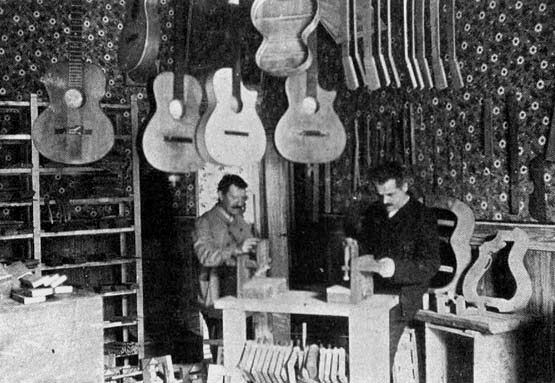











First 900' MOZZANI , CLASSIC STUDIO NYLON, Natural, EX+
code AC444 -
back and sides : red poplar
sounboard : spruce
neck : maple
http://www.justclassicalguitar.com/pen&nail/900/it/Mozzani.php
http://www.duozigiottimerlante.it/mozzani.htm
http://www.youtube.com/watch?v=dlPIbV9hjGE
Tratto da un forum:
"In collezione ho un violino (pubblicato a Londra, che non
venderei mai) ed un mandolino-padellino, entrambi del 1938. Una volta tenemmo un
incontro-conferenza con un altro amico, Carlo Domeniconi,
che suona con una chitarra di Mozzani, del 1938 pure quella. Mozzani era molto
legato al regime di allora e sembra che in quell'anno il suo laboratorio
omnicomprensivo ( dove i giovani di bottega impararono sino a divenire maestri
importantissimi, specie nella costruzione di strumenti ad arco) produsse molti
"pezzi", in gran parte destinati all'esportazione, particolarmente in Germania.
Un libro interessante su Mozzani costruttore è quello di Giovanni Intelisano,"
MOZZANI, Un liutaio e la sua arte", Arts & Crafts, Cento (FE), 1990. Contiene
riproduzioni di foto d'epoca, di manoscritti anche musicali, di disegni e di
strumenti vari. A pag 48 c'è una foto di Mozzani mentre suona una chitarra
modello Guadagnini di sua produzione."
Carlo Domeniconi
Luigi
Mozzani was born on March 9, 1869 into a family of very modest means. As
typical of his class, Luigi was forced to follow his father into the
shoemaking business. He abandoned this activity after nine years, gaining
work as a barber. He learned to play clarinet and bugle, playing in a band,
but quickly abandoned it for health reasons. When he was lent an old guitar,
he repaired it and thus began his study of lutherie. Still looking for a way
to earn a living, and not finding employment as a clarinetist, he began to
study the oboe. After successful enrollment in the Musical Grammar school
of Bologna, he was able to obtain work such as First Oboe with the Saint
Carl Theatre of Naples. This profession came to an end after an ill-fated
tour of America with an orchestra under the direction of Arthur Toscanini,
who stranded Mozzani in America for about two years. Mozzani next joined a
banjo trio, which began his career of performing guitarist and, later,
guitar teacher. In 1896, he published three volumes of Studies for Guitar.
Towards the end of the century, after a successful concert tour of Europe,
he went to Paris to study guitar construction. He settled in Bologna, where
he continued his work as a luthier in collaboration with two Neapolitan
mandolin builders. It was in 1909 that Mozzani, on a trip to Vienna, came
into contact with the harp guitars of Schenck. He immediately appropriated
these new designs into his work, both as a luthier and performer, always
experimenting to create the ideal guitar. Still in demand as a concert
artist, Mozzani alternated between performance tours and his role as
director of the “laboratory” (lutherie workshop), letting others handle the
actual construction. The success of the shop enabled Mozzani and team to
move to larger quarters in Cento. Between 1915 and 1924, they concentrated
on a full range of instruments for Plectrum Orchestra (counterpart to
America's Mandolin Orchestras). In 1929, the Mozzani laboratory-school was
granted official status, with famed violinmaker Claudio Gamberini put in
charge of plucked instruments. Just four years later, the school was closed
for “political reasons,” and Mozzani again set up a private workshop, in
collaboration with Gamberini and Rino Federici. They continued to have
success with their instruments, particularly after Andreas Segovia himself
chose a Mozzani guitar (standard 6-string). Mozzani continued to perform
publicly until 1939, when he recorded three discs of a variety of music. He
never gave up on the idea of a lutherie school, and finally, with interest
of the local authorities, he succeeded in opening another in the province of
Trento. After Mozzani’s death on August 12, 1943, the school continued under
Federici’s direction until 1947, when it closed for good, the inventory
being sold.

Mozzani shop 1906
